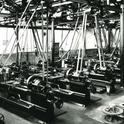Right from the earliest days of the movies, audiences must have felt like shouting, "Look how much I can see!" The phrase, and its exclamation mark, express the pleasure of discovering new categories of visual experience in cinema: moving-image travelogues of camels at the pyramids or Tsarist splendour in Russia in the late 1890s; close-ups of the luminous faces of something called a movie star in the late 1910s; the sweeping Technicolor fantasies of the 1930s; the "liquid metal" computer-generated effects of Terminator 2 in the early 1990s. The cinema image began as a pale, fuzzy, flickering, monochrome imitation of the brilliance of human sight, and has been marching ever since towards rendering such visual detail on screen.
In recent years, thanks to digital technology, that march has speeded up to the extent that I now want to shout "Look how much I can see!" at least once a year. Today's shooting and projection technologies have an unprecedented power of visual mimesis. Perhaps speeding cinema will never match the neuro-retinal complexities of actually witnessing an event, but it is getting close.

The technical reasons for this are worth mentioning, because they show that cinema is halfway through its great transition from photochemistry to digital. The movie was shot by Roger Deakins on super-35mm, a method whereby the area of the 35mm negative usually reserved for the soundtrack is instead allocated to the image, allowing about one third more visual information than standard 35mm, still the industry norm. Then the film was scanned on to a computer, creating a digital intermediate. As some of the scenes were shot in low light, this allowed Deakins and his team to improve this intermediate, adding light to faces and other elements that might otherwise have been only partially visible. Finally, in the screening I attended, the film was projected digitally, removing any of the small wobbles ("gate movement" or "weave") that sometimes occur in a film projector and are magnified on screen, and ensuring that the focus was pin sharp throughout.
Neither super-35, digital intermediate nor digital projection are completely new in themselves, but when you add them together you get an unprecedented visual crispness and clarity. Compared to any frame of Jesse James, Terrence Malick's beautiful 1978 film Days of Heaven looks like it was drawn in soft pastel crayons.
But the technology is only half the story. The Assassination of Jesse James by the Coward Robert Ford is based on a 1983 novel of the same name by Ron Hansen, which, says Deakins, is "full of detail and really sets you in the world." The film's New Zealander writer-director Andrew Dominik was determined to mirror this detail, and does so in a number of ways. Scenes are long. There are pauses between lines of dialogue. The camera is often close in on the faces of Pitt and, in particular, Affleck. We see the actors think before they speak. We see not only their facial movements but the tiny muscles around the edges of their eyes. Affleck's character is the super-fan of the now legendary Jesse James. We watch, close up, as he almost swoons in James's presence, his eyelids drooping woozily, ecstatically, as in Bernini's sculpture The Ecstasy of St Theresa.
This famous encounter between two men has fascinated filmmakers for decades, and Dominik didn't only want to film the key dramatic moments. He was interested in the fine-grained micro-psychology of all their time together, even when this was just sitting around tables or campfires. The meaning of the book was in its detail—cinema today can photograph detail like never before, and so Dominik forced a studio-star system that loves dash, fast editing and car chases into an uncustomary, patient, pointillist portrait of two men slowly realising that each's destiny is in the hands of the other. We watch as Ford begins to resent the fact that his fan-boy adoration is unrequited. The devotee senses that, since his ardour "made" Jesse, his ire can unmake him. And so Ford shoots him, and Jesse colludes in his own shooting, as if he's tired of being a legend but accedes to what he knows will become a legendary demise. We see these thoughts in the faces of Affleck and Pitt. The detail "sets you in the world."
Perhaps it is the slow pace that has caused this $30m film, headlined by one of the world's most famous movie stars, to take less than $4m in the US. Perhaps it is its arty title. The fact that it is about the pathology of fandom must make it an edgy watch for Brad fans, especially as he seems to be playing himself. However, despite the moaning from many US and British critics that it is slow and boring, The Assassination of Jesse James by the Coward Robert Ford is a masterpiece and a small landmark in the history of cinematic humanism. From The Passion of Joan of Arc (1928), at least, movies have tried to take us elsewhere, into the minds of characters, by sustainedly looking into faces. The technology of the movies is allowing us to do this looking, and to visit this elsewhere, more clearly than ever before. In the era of Facebook, face films are astonishing.











